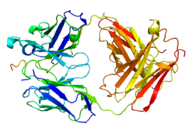We make "YOUR FUTURE"

Osteopontin(OPN), also called bone sialoprotein 1 (BSP-1 or BNSP), it is a protein encoded by the SPP1 gene (secretory phosphoprotein 1) in humans.
This gene has seven exons, is 5 kilobases, and is located on the long arm of chromosome 4 region 22 (4q1322.1) in humans. This protein is composed of up to 300 amino acids residues and has up to 30 carbohydrate residues attached, including 10 sialic acid residues, during post-translational modification in the Golgi apparatus.
Structure ( General Structure )
OPN is a strongly negatively charged extracellular matrix protein. It is biosynthesized as a 33-kDa nascent protein consisting of about 300 amino acid residues,
and after translational modification, it may have a molecular weight of about 44 kDa at the time of secretion.
Biosynthesis
Synthesis of OPN is stimuteded in its productive cells, which are exposed to pro-inflammatory cytokines, classic mediators of acute inflammation
(eg, tumor necrosis factor α [TNF-α], interleukin-1β [IL-1β]), angiotesin Ⅱ, transforming growth factor β (TGFβ) and parathyroid hormone (PTH),
OPN expression is also increased in hyperglycemia and hypoxia.
Biological function
< Role in immune functio >
OPN functions as an adhesive protein, is involved in cell attachment and wound healing, and regulates (suppresses) the progression of apoptosis through cell activation
and cytokine production.
Potential clinical applications
The fact that OPNs interact with multiple cell surface receptors expressed in ubiquitous is a number of physiology,
including wound healing, bone metabolism, tumor formation, inflammation, ischemia, and immune response. It has become an important player in the pathological process and is thought to be useful in the regulation of plasma (or local) OPN
levels, in the treatment of autoimmune diseases, cancer metastasis, osteoporosis, etc.